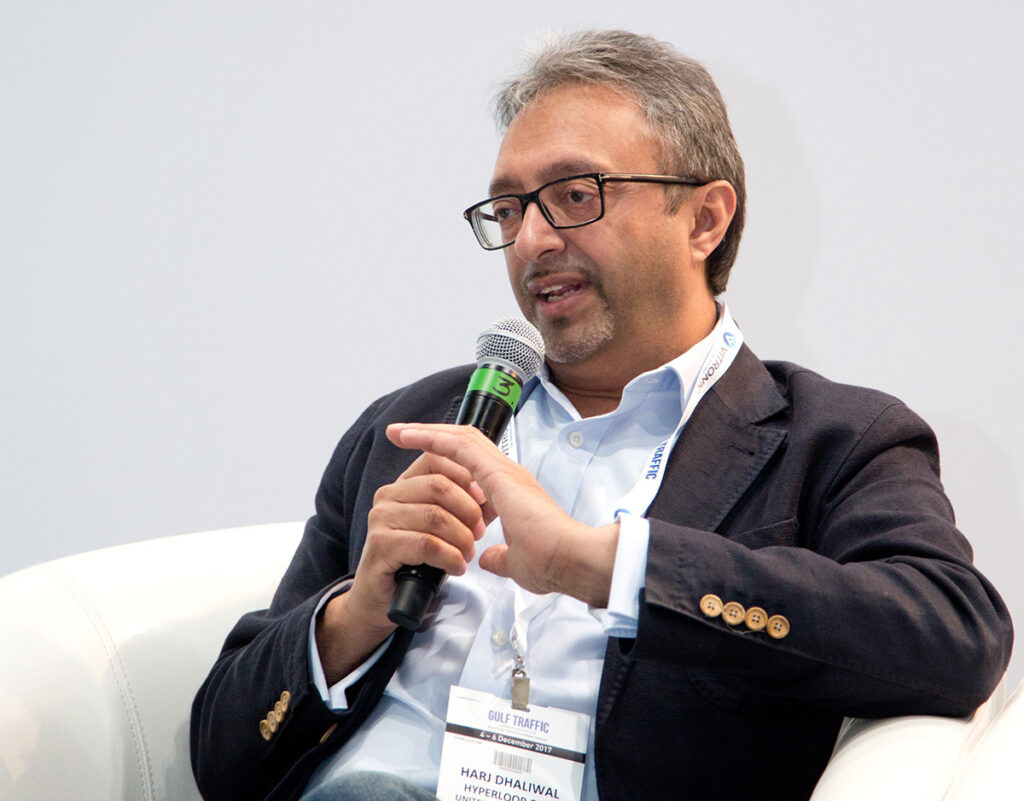
Harj Dhaliwal (Hyperloop One)
“HYPERLOOP: SOON A REALITY IN SOME COUNTRIES“
Sometimes a disruptive innovation changes the way people organise their activities, social and working life (e.g., train, car, print, internet etc…). The next one is likely to be the Hyperloop. Conceived by the visionary entrepreneur Elon Musk, the technology has now being developed by Hyperloop One (formerly Hyperloop Technologies Inc.), Hyperloop Transportation Technologies (HTT), and Transpod. With speeds 2-3 times faster than high-speed rail and an on-demand, direct to destination experience, hyperloop technology can reduce journey times, exponentially increasing connectivity inside and across countries. Many project are being developed in the Middle East, in the Kingdom od Saudi Arabia and the United Arab Emirates. Hyperloop across GCC countries can soon become a reality. But also some European Countries are working on this technology and with a Long Term Vision in mind they can ride this important technological shift. What are the advantages of such a form of transport? Where we first will be able to travel on an hyperloop pod? What is needed to develop the infrastructure? Harj Dhaliwal, Managing Director Middle East & India at Hyperloop One, answered to these and other questions.
For further details –
https://hyperloop-one.com/
INTERVIEW – (July 2018)
This interview was made in June and published in July 2018 on www.lteconomy.org
Subject: Climate Change policies in Hong Kong
By Dario Ruggiero, Founder of Long Term Economy
Highlights
- Hyperloop is the first new mode of public transport in 100 years… We propel the pod using a proprietary linear electric motor… and once the pod gets going, it lifts off the track using magnetic levitation.
- We are designing this system with sustainability in mind… higher energy efficiency per passenger kilometre, no direct emissions or noise, and 100% electric. Safety is our number-one priority… Our technology is fully autonomous and operates in a closed system…
- The Dubai – Abu Dhabi route is one of the projects we are exploring with the RTA (Roads and Transport Authority). We completed Phase 1 of our collaboration…and will contribute to transform 25 percent of total journeys in Dubai into driverless transport using different means by 2030.
- … our goal is to make hyperloop travel affordable for everyone. It’s difficult to predict an exact price range at the moment…, but prices will be comparable to existing public modes of transport taking into account benefits in time savings…
- We recently announced the launch of DP World Cargospeed, a global brand for hyperloop-enabled cargo systems operated by DP World capable of supporting fast, on-demand, direct delivery of high value light weight time sensitive cargo.
- We are seeing a global demand for hyperloop technology. Earlier this year we signed a Framework Agreement with the Indian state of Maharashtra to develop and then build the Pune-Mumbai hyperloop route connecting 26 million people in 25-minutes.
- The vision of national hyperloop connections can be achieved in years, not decades, but it needs governments that are forward-thinking, embrace innovation and willing to invest in their countries long term infrastructure to release the long term economic benefits. I see no reason why that cannot be Italy!
⇓
“Hyperloop is the first new mode of public transport in 100 years…
We propel the pod using a proprietary linear electric motor.
It accelerates the pod safely and gradually at
the same speed of a commercial jet’s take-off”
Question 1 | What Hyperloop is?
Hyperloop is the first new mode of public transport in 100 years. Here is some background on how it works: you start with a pod in a tube. Air is removed from the tube, which eliminates aerodynamic drag and weather hazards. We propel the pod using a proprietary linear electric motor. It accelerates the pod safely and gradually at the same speed of a commercial jet’s take-off. And once the pod gets going, it lifts off the track using magnetic levitation. It glides in a near vacuum for many kilometres with no additional energy, or noise or friction. Last year, we proved this technology when we successfully built and tested the world’s first full scale, full system hyperloop in North Las Vegas Nevada.
We are designing this system with sustainability in mind. High-speed rail and maglev trains require power along the entire track, Virgin Hyperloop One systems only require energy for a portion of the track. The system is designed to have higher energy efficiency per passenger kilometre, no direct emissions or noise, and is 100% electric.
Safety is our number-one priority and we’re designing the hyperloop to be inherently safe and more reliable than a maglev. Our technology is fully autonomous and operates in a closed system – immune to fluctuating weather and other unforeseen third party interventions such as stray animals, unauthorised public access etc. Our safety team is currently working with world class experts and government bodies around the globe to set up an international safety body for all forms of hyperloop transport. In fact in May 18 we hosted the very first meeting of the Hyperloop International Safety and Standards Working Group.
Virgin hyperloop one ‘pod’

⇓
Question 2 | Dubai – Abu Dhabi project
One of the recent news concerns the development of a Hyperloop infrastructure in the United Arab Emirates. It will connect Dubai and Abu Dhabi (a 87-mile – 140 kilometres – trek) in just 12 minutes by 2021. Can you tell us more about the project: investment-costs, time and passenger capacity?
The Dubai – Abu Dhabi route is one of the projects we are exploring with the RTA (Roads and Transport Authority). We completed Phase 1 of our collaboration with the RTA earlier this year and are currently developing Phase 2, which will include a detailed study to explore the viability of a UAE-wide Virgin Hyperloop One network. We are fully aligned with the RTA and look forward to creating a viable and well thought out transport system that will create the maximum benefit for passengers and cargo. More on this soon!
⇓
Question 3 | Why the UAE
What has made the UAE one of the first countries in implementing the Hyperloop? Is it a question of country vision, bureaucracy, money, open-minded politicians or what else?
The UAE is a great partner for Virgin Hyperloop One. The country has a strong, innovation-led mentality, a government that via Sheikh Mohamed Bin Rashid Al Maktoum has created a platform for new bold innovative companies and technologies like Virgin Hyperloop One to establish through the Future Foundation Organisation and to come into the region to further develop themselves and the region as world leaders. The RTA and UAE government are constantly pushing the boundaries of innovation in transport and one of their goals is to transform 25 percent of total journeys in Dubai into driverless transport using different means by 2030. In fact Virgin Hyperloop One’s technology and systems developed in the UAE would support this goal as we too, are completely autonomous. Couple that with a tremendous business climate, and a desire to become a world renowned hub for innovation it’s an ideal opportunity an location for us to set up our first office outside the USA.
Hyperloop one infrastructure

“As the first new mode of public transportation in 100 years,
our goal is to make hyperloop travel affordable for everyone.
It’s difficult to predict an exact price range at the moment…
but prices will be comparable to existing public modes of transport”
Question 4 | Is it only for the élite?
As the first new mode of public transportation in 100 years, our goal is to make hyperloop travel affordable for everyone. It’s difficult to predict an exact price range at the moment seeing as numerous factors including the route are yet to be determined, but prices will be comparable to existing public modes of transport taking into account that benefits in time savings will be significant over the current modes.
Also, Hyperloop transport will be entirely on demand – that means no timetables. The system will be dynamic with the ability to deploy pods based on up-to-the-second data points that continually optimise departures and arrivals. To clarify, pods will carry 10-15 passengers, with multiple pods deployed per minute. In addition, hyperloop systems will be able to utilise their capacity for both passengers and palletised freight, maximising value as the technology helps support industrial clusters
⇓
Question 5 | The Hyperloop and the cargo transport
Yes! We recently announced the launch of DP World Cargospeed, a global brand for hyperloop-enabled cargo systems operated by DP World capable of supporting fast, on-demand, direct delivery of high value light weight time sensitive cargo. Designed to provide exceptional service for high-priority, on-demand goods, DP World Cargospeed systems will deliver freight at the speed of flight and closer to the cost of trucking.
Hyperloop doesn’t just get goods from A to B faster and cheaper, it revolutionises supply chain-manufacturing. A hyperloop-enabled supply chain can help reduce finished goods inventory by 25%, cut required warehouse space by 25%, and shrink inventory lead times. This can add up to far more than the savings in transportation costs, especially for high value and time sensitive products.
DP World Cargospeed

“The vision of national hyperloop connections can be achieved in years,
not decades, but it needs governments that are forward-thinking,
embrace innovation and willing to invest in their countries long term
infrastructure to release the long term economic benefits”
⇓
Question 6 | Hyperloop in the world
We are seeing a global demand for hyperloop technology. Earlier this year we signed a Framework Agreement with the Indian state of Maharashtra to develop and then build via a very structured process the Pune-Mumbai hyperloop route which will link central Pune, Navi Mumbai International Airport, and Mumbai in 25-minutes, connecting 26 million people. India clearly saw the saw the economic advantages of our technology. We are also seeking a second route to develop in India.
The Middle East remains a big market for us and we continue to work closely with the governments in the region especially the government and authorities in the Kingdom of Saudi Arabia where we have been discussing several possible opportunities which we believe will assist in delivering their transformation agenda that is now well and truly underway in this exciting country. In the US, we have had three states that have started feasibility studies – Ohio, Missouri and Colorado and these studies are all progressing very well.
⇓
Question 7 | Hyperloop in Italy
We are from Italy. Do you think will we see it soon here? I hope yes…
The vision of national hyperloop connections can be achieved in years, not decades, but it needs governments that are forward-thinking, embrace innovation and willing to invest in their countries long term infrastructure to release the long term economic benefits. Benefits that create highly skilled jobs, improve productivity, reduce costs and seek to use our technology to truly redress the economic in-balance across regions and provide opportunities for all. I suppose a government that can give back time will be very popular! I see no reason why that cannot be Italy!
Inside the Hyperloop

⇓
